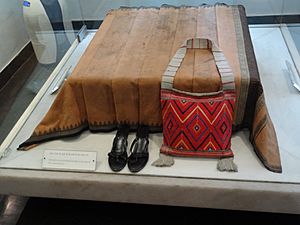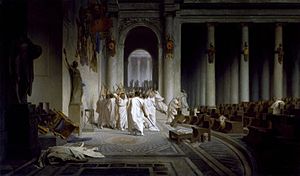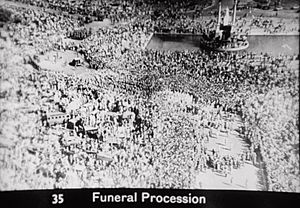Assassination facts for kids
Assassination is the murder of an important or popular person. Usually the person is a political leader, like the head of a country or a political party. Assassinations are usually done for political reasons or for payment. A person who assassinates someone is called an assassin.
Throughout history, assassinations have happened for many different reasons. Sometimes assassinations have been used to take over governments. Other times, assassinations have been used to kill military leaders during wars, or for religious reasons. Some assassins want revenge, or just want to be famous.
Contents
In ancient to medieval times
Assassinations have happened ever since people started living in group societies.
The Old Testament of the Bible talks about assassinations in the Books of Judith, Kings, Samuel, and Chronicles.
An ancient Indian writer named Chanakya, who lived from about 350 – 283 BC, wrote a lot about assassinations in a book called Arthashastra. One of his students later assassinated some of his enemies, including two of Alexander the Great's generals.
Famous victims of assassinations include Philip II of Macedon (336 BC), Alexander the Great's father, and Julius Caesar (44 BC). Emperors of the Roman Empire were often assassinated so that a different leader could take their place.
In the Middle Ages, many kings in the Eastern Roman Empire were killed by assassinations so that new kings could take power.
During the Renaissance, assassinations became more common in Western Europe. Kings William the Silent of the Netherlands (1584), Henry III of France (1589),, and Henry IV of France (1610) were all assassinated.
The first American use of state assassination (where a government planned to assassinate someone) happened in 1620. It happened in Plymouth in the Massachusetts Bay Colony, where the Pilgrims had landed. Native Americans had lived there before the Pilgrims landed, but the Pilgrims wanted the land to themselves. Myles Standish invited a local Native American tribal chief, the chief's 18-year-old brother, and two other Native Americans to a feast. Then they locked the door, killed the three older men, and hanged the teenager in public as a warning to the other Native Americans to stay away.
In modern history
Assassinations have been common in modern history. This section does not list every assassination that has happened in modern history. It lists some examples of world leaders who were assassinated, and explains some of the reasons why these assassinations happened.
In Imperial Russia, two emperors were assassinated within 80 years: Paul I (1801) and Alexander II (1881).
In the United States, four presidents were assassinated within 100 years. They were Presidents Abraham Lincoln (1865), James Garfield (1881), William McKinley (1901), and John F. Kennedy (1963).
After Abraham Lincoln was killed, Andrew Johnson became President. He was President for four years. During that time, 12 people who held important political jobs were assassinated. The next president, Ulysses S. Grant, led the United States from 1869–1877. During that time, 11 government leaders were assassinated; another 9 were attacked, but survived.
The World Wars
Archduke Franz Ferdinand of Austria was assassinated in 1914. Some historians say this assassination started World War I.
In the 1930s and 1940s, Josef Stalin's NKVD assassinated many people outside of the Soviet Union, including Leon Trotsky. These were mostly people who Stalin thought were against him or could take power from him. He wanted to make sure to keep the power he had, so he killed many of his opponents.
Between 1934 and 1944, different individuals and groups tried 27 different times to assassinate Adolf Hitler, the leader of Nazi Germany during The Holocaust and World War II. These people wanted to stop Hitler from taking over so many countries and killing so many people. However, he always survived.
During World War II, the Allies used assassinations to kill important Nazi and Japanese leaders:
- Czech soldiers assassinated Reinhard Heydrich, one of the most important people in the Nazi government (1942)
- The United States Army assassinated Japanese Admiral Isoroku Yamamoto, an important military leader (1943)
- Polish rebels assassinated top Nazi leaders whenever they could
Activists
Some famous human rights activists were also assassinated in the next few decades. They were assassinated by people who did not like the things they were doing to work for human rights. The most famous activists who were assassinated include:
- Mohandas Gandhi (1948), a leader of non-violent protests against British control over India
- Malcolm X (1965), a civl rights leader
- Martin Luther King, Jr. (1968), one of the most important leaders of the African-American Civil Rights Movement
The United States CIA (1960 – 1970)
Between 1960 and 1965, the United States Central Intelligence Agency (CIA) tried at least eight times to assassinate Cuban leader Fidel Castro. Around this time, the CIA also made plans to assassinate Patrice Lumumba, the only democratically elected leader of the Democratic Republic of the Congo.pp.19-24
Between 1960 and 1970, the CIA also encouraged – and in some cases helped with – assassination plans against:
- Rafael Trujillo, the President of the Dominican Republic
- Ngo Dinh Diem, the President of South Vietnam
- General Rene Schneider, the head of the Chilean Army, who refused to let the Army overthrow the democratically elected president, Salvador Allende
The 1970s – 1980s

In 1979, the Iranian Revolution turned Iran into an Islamic Republic. A group called Iran Human Rights Documentation Center says that between 1979 and the 1990s, leaders of the Iranian government had 162 people assassinated, in 19 different countries. The group says Iran stopped the assassinations because a German court put out an arrest warrant for the head of Iranian military intelligence.
Anwar Sadat, the President of Egypt, was assassinated in 1981 at a parade. He was killed by people who wanted to take over the country and make it into an Islamic Republic.
In 1983, Benigno Aquino, Jr. was assassinated. Aquino was against Ferdinand Marcos, the dictator who ruled the Philippines. The people of the Philippines were so upset that they started the non-violent People Power Revolution. This led to the end of Marcos's government. Aquino's widow, Corazon Aquino, became President of the Philippines.
In India, Prime Minister Indira Gandhi was assassinated in 1984. Her son Rajiv Gandhi became the next Prime Minister. He was assassinated in 1991. (They were not related to Mohandas Gandhi.)
The 1990s to today
Israeli Prime Minister Yitzhak Rabin was assassinated in 1995. The Israelis and Palestinians were working on a peace agreement. Rabin was killed by an Orthodox Jew who did not agree with the peace treaty. Many historians think Rabin's murder is one of the main reasons the peace talks fell apart.
In Pakistan, Benazir Bhutto was assassinated in 2007. Bhutto had been the first woman ever elected to lead a Muslim country.
Statistics
One research study looked at assassinations of national leaders (leaders of countries, like presidents or prime ministers). The study showed that:
- Since 1895, assassins have tried to kill national leaders 298 different times. 59 of those world leaders were killed.
- Since 1950, a national leader has been assassinated in nearly 2 of every 3 years.
Another study looked at all assassinations between 1946 and 2013. It included not just national leaders, but also other members of government (including local governments), and people who were against the government. This study found that between 1946 and 2013, a total of 954 people were assassinated in 758 different attacks.
This study also looked at who was most likely to be assassinated. Of those 954 people who were assassinated:
- 21% were members of parliament
- 18% were opposition leaders (leaders of political parties or groups that spoke out or fought against the government)
- 17% were national leaders
- 14% were government ministers
- 10% were diplomats
- 5% were local politicians, like governors or mayors
Images for kids
-
Rifle of Lee Harvey Oswald, the assassin of President John F. Kennedy
-
Derringer of John Wilkes Booth, the assassin of President Abraham Lincoln
-
Predator combat drone; sometimes used in targeted killings
-
Pope Benedict XVI in a modified Mercedes-Benz M-Class Popemobile in São Paulo, Brazil
See also
 In Spanish: Magnicidio para niños
In Spanish: Magnicidio para niños








